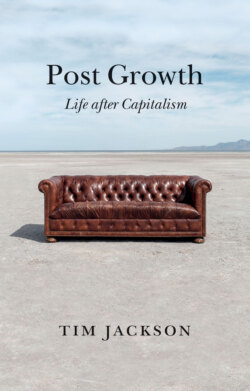Читать книгу Post Growth - Tim Jackson - Страница 14
The stationary state
ОглавлениеEven as Kennedy was talking in Kansas, a young agricultural economist named Herman Daly was about to publish his first mainstream paper. He had been working on it since 1965. The principal argument in ‘Economics as a Life Science’ was that ultimately economics and biology were both engaged in the study of one and the same thing: the life process itself.
It’s a sentiment that runs to the core of the arguments I want to develop in this book. An appeal to economists to understand that the economy is not a separate or even separable part of the natural world, but a ‘wholly owned subsidiary’ of the environment. Daly was in Brazil when he submitted the paper to the prestigious Journal of Political Economy, without access to sophisticated office equipment. So the manuscript was in rough copy with handwritten corrections on it. To his surprise it was accepted immediately. It appeared in print in May 1968, just a couple of months after Kennedy’s critique of the GDP.19
The timing was such an odd coincidence that I couldn’t help wondering if Daly had known about the Kennedy speech or had any connection to it. He’d only become aware of it much later, he told me. But the two direct influences on Kennedy – Carson’s Silent Spring and the writing of the American liberals – were of course familiar to him. Galbraith’s The Affluent Society in particular had had a profound impact on him as a young economics undergraduate.20
In the years that followed the publication of ‘Economics as a Life Science’, Daly began to flesh out more and more of the science that became known as ecological economics. At the centre of his inquiry was the question of scale. How could the human economy simply keep on growing when the dimensions of the planet were irredeemably finite? Ultimately, argued Daly, it couldn’t. In the early 1970s, he published the foundations for what he began to call the ‘steady state’ economy – defined as one with a constant stock of capital and a constant population. Crucially, the size of this constant stock had to be small enough that the flow of material and energy needed to maintain it lay within the carrying capacity of the planet. Otherwise it would eventually collapse. It was ‘an extension of the demographers’ model of a stationary population to include the populations of physical artifacts’, he wrote in 1974. The same fundamental idea ‘is found in [the economist] John Stuart Mill’s discussion of the stationary state of classical economics’.21
Here we arrive at one of the most curious aspects of cultural myth. Each culture is blind to its own mythical nature. We are consigned to live inside the bubble. Like Jim Carrey’s character Truman Burbank in Peter Weir’s movie The Truman Show, everything appears to be real. The routines of our life and the boundaries of our world seem immutable. From inside the bubble, growth is the irreducible norm and the concept of the stationary state looks like an insane aberration. Zoom out for a second and the roles are completely reversed. One of the founding fathers of the science of economics had written about the postgrowth economy two and a half centuries ago.
John Stuart Mill professed to a profound dislike of the society springing up around him at the height of the industrial revolution. ‘I am not charmed with the ideal of life held out by those who think that the normal state of human beings is that of struggling to get on, that the trampling, crushing, elbowing, and treading on each other’s heels, which form the existing type of social life, are the most desirable lot of human kind,’ he wrote in his Principles of Political Economy, published in 1848. Of the stationary state itself he admitted: ‘I cannot regard it with the unaffected aversion so generally manifested toward it by political economists of the old school.’ On the contrary, he said, ‘I am inclined to believe that it would be, on the whole, a very considerable improvement on our present condition.’22
In other words, the great classical economist was saying this: a postgrowth world may be a richer, not a poorer, place for all of us. And it’s that vision of a richer, more equitable, more fulfilling world – glimpsed by Mill and demanded by Kennedy and developed by Daly – which provides the inspiration for the arguments in this book.
